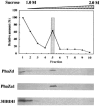Properties of a novel intracellular poly(3-hydroxybutyrate) depolymerase with high specific activity (PhaZd) in Wautersia eutropha H16
- PMID: 16199568
- PMCID: PMC1251622
- DOI: 10.1128/JB.187.20.6982-6990.2005
Properties of a novel intracellular poly(3-hydroxybutyrate) depolymerase with high specific activity (PhaZd) in Wautersia eutropha H16
Abstract
A novel intracellular poly(3-hydroxybutyrate) (PHB) depolymerase (PhaZd) of Wautersia eutropha (formerly Ralstonia eutropha) H16 which shows similarity with the catalytic domain of the extracellular PHB depolymerase in Ralstonia pickettii T1 was identified. The positions of the catalytic triad (Ser190-Asp266-His330) and oxyanion hole (His108) in the amino acid sequence of PhaZd deduced from the nucleotide sequence roughly accorded with those of the extracellular PHB depolymerase of R. pickettii T1, but a signal peptide, a linker domain, and a substrate binding domain were missing. The PhaZd gene was cloned and the gene product was purified from Escherichia coli. The specific activity of PhaZd toward artificial amorphous PHB granules was significantly greater than that of other known intracellular PHB depolymerase or 3-hydroxybutyrate (3HB) oligomer hydrolases of W. eutropha H16. The enzyme degraded artificial amorphous PHB granules and mainly released various 3-hydroxybutyrate oligomers. PhaZd distributed nearly equally between PHB inclusion bodies and the cytosolic fraction. The amount of PHB was greater in phaZd deletion mutant cells than the wild-type cells under various culture conditions. These results indicate that PhaZd is a novel intracellular PHB depolymerase which participates in the mobilization of PHB in W. eutropha H16 along with other PHB depolymerases.
Figures






References
-
- Berg, J., J. Tymoczko, and L. Stryer. 2002. Biochemistry, 5th ed., p. 190-225. W. H. Freeman and Company, New York, N.Y.
-
- Bernhard, M., B. Benelli, A. Hochkoeppler, D. Zannoni, and B. Friedrich. 1997. Functional and structural role of the cytochrome b subunit of the membrane-bound hydrogenase complex of Alcaligenes eutrophus H16. Eur. J. Biochem. 248:179-186. - PubMed
-
- Cumming, R. C., N. L. Andon, P. A. Haynes, M. Park, W. H. Fischer, and D. Schubert. 2004. Protein disulfide bond formation in the cytoplasm during oxidative stress. J. Biol. Chem. 279:21749-21758. - PubMed
Publication types
MeSH terms
Substances
LinkOut - more resources
Full Text Sources
Other Literature Sources
Molecular Biology Databases

